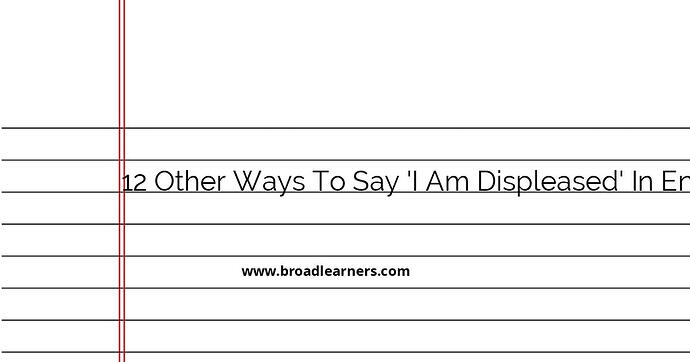Expressing displeasure or dissatisfaction is a common part of communication. Instead of repeatedly saying 'I am displeased', it can be helpful to have a variety of alternative phrases at your disposal. This article presents 12 other ways to say 'I am displeased' in English:
- I am not happy with this
- This is unacceptable
- I am not pleased
- I am dissatisfied
- I am disappointed
- This is not to my liking
- I am frustrated
- I am annoyed
- I am irritated
- This is not what I expected
- I am underwhelmed
- This does not meet my expectations
Using any of these alternatives can help you effectively express your displeasure without repeating the same phrase over and over. Below, you will find explanations and examples for each alternative phrase:
1. I am not happy with this
This phrase conveys that you are dissatisfied with a specific situation or outcome. It is a straightforward way to express your displeasure without being overly negative or confrontational.
Example:
I am not happy with this decision. I believe there are better solutions we should consider.
2. This is unacceptable
When something falls short of your expectations or is against your standards, stating 'This is unacceptable' clearly communicates your displeasure and sets a clear boundary.
Example:
This kind of behavior is unacceptable in a professional setting. It needs to be addressed immediately.
3. I am not pleased
This phrase is simple and direct, expressing your lack of satisfaction or contentment with a particular situation. It can be used in both professional and informal contexts.
Example:
I am not pleased with the quality of work that was delivered. It does not meet the standards we agreed upon.
4. I am dissatisfied
'I am dissatisfied' implies a feeling of disappointment or discontent with a specific situation or outcome. It conveys that you expected more or better results.
Example:
I am dissatisfied with the level of customer service I received. The issue needs to be resolved promptly.
5. I am disappointed
Expressing disappointment conveys a sense of sadness or letdown due to unmet expectations. It can be used informally or formally, depending on the context.
Example:
I am disappointed with the team's performance. We need to work together to improve our results.
6. This is not to my liking
This phrase communicates that something does not suit your personal preference or taste. It is a milder way to express your displeasure without sounding overly negative.
Example:
This new design is not to my liking. I preferred the previous version.
7. I am frustrated
When you feel annoyed or impatient due to obstacles or difficulties, expressing frustration conveys your dissatisfaction while acknowledging the challenges you are facing.
Example:
I am frustrated with the constant delays in project timelines. It is affecting our productivity.
8. I am annoyed
This phrase indicates irritation or exasperation with a particular situation or behavior. It conveys your displeasure while maintaining a direct and concise tone.
Example:
I am annoyed by the lack of communication and transparency in this project. It is causing unnecessary confusion.
9. I am irritated
When something or someone consistently bothers you or frustrates you, saying 'I am irritated' expresses your displeasure and discomfort.
Example:
I am irritated by the constant interruptions during our meetings. It is disruptive to our workflow.
10. This is not what I expected
When a situation or outcome does not align with your initial expectations or assumptions, expressing that 'This is not what I expected' conveys your disappointment or surprise.
Example:
This report is not what I expected. It lacks the depth and analysis we discussed.
11. I am underwhelmed
'I am underwhelmed' expresses a feeling of disappointment or unimpressiveness. It implies that something did not meet the level of excitement or quality you were anticipating.
Example:
I am underwhelmed by the product's performance. It does not live up to the advertised features.
12. This does not meet my expectations
When a situation or outcome falls short of what you expected or desired, stating that 'This does not meet my expectations' clearly conveys your displeasure and dissatisfaction.
Example:
This proposal does not meet my expectations. It lacks the comprehensive analysis and strategic approach we need.
By incorporating these alternative phrases into your vocabulary, you can effectively express your displeasure or dissatisfaction in a variety of situations. Remember to choose the phrase that best suits the context and maintain a professional tone.
Did I miss anything? Respond below
